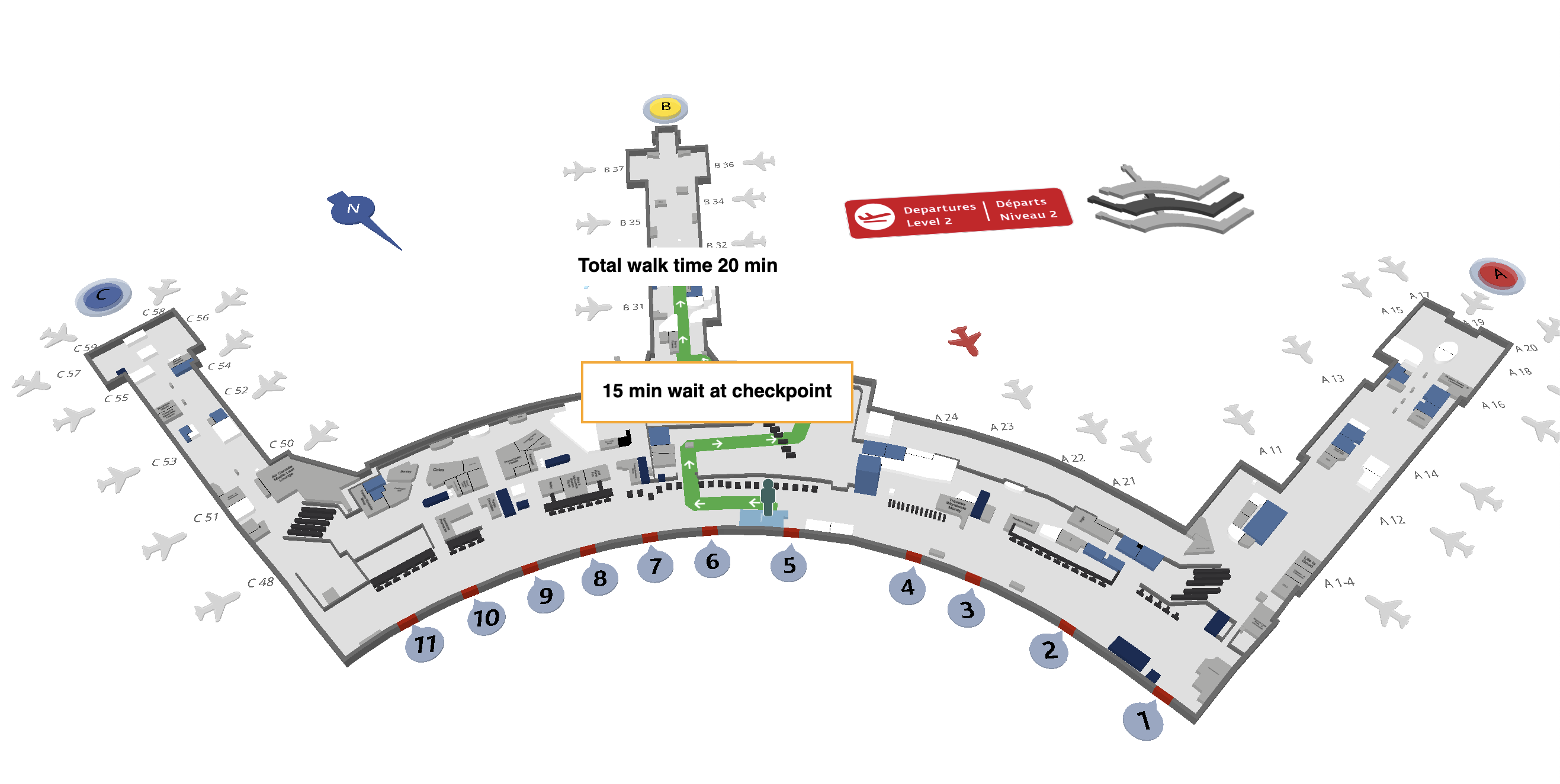Return to Resources
Interactive Multi-building Navigation for Airports
Jul 28, 2022
5 min read
How can airports reduce passenger stress and enhance the overall travel experience? By equipping passengers with easy-to-use digital maps that also provide seamless wayfinding between buildings, parking lots, and shuttle services with multi-building navigation.
Using Multi-building Navigation for Airports
With multi-building navigation, a feature of Mappedin’s Responsive Web App, passengers can enjoy seamless outdoor-indoor navigation between buildings and airport locations. As well as navigating to gates, terminals, and facilities inside an airport, passengers can efficiently search and locate parking lots, airport hotels, shuttle services, and buildings around an airport.

Why is Multi-building Navigation for Airports So Effective?
Multi-building navigation allows travelers to populate the most efficient route to their destination, something that is crucial when timing is of the utmost importance. With access to a digital airport map, passengers can quickly get acquainted with their surroundings as they pan, zoom, and rotate the interactive display. With the addition of blue dot wayfinding, users can view their real-time location on the map as they travel through indoor and outdoor locations.
Why Its Important for Airports
Major airports and transportation hubs have countless passengers and staff traveling through them every day. Not only are these crowded hubs full of passenger traffic and stressful to navigate, but they are also difficult for property managers and facility teams to manage. With digital mapping and navigation, transportation hubs can ameliorate the travel experience for passengers, while also equipping staff and management with the tools to update their floor plans in real-time and gain valuable insights.
Seamless Outdoor-Indoor Airport Wayfinding
With a robust indoor mapping platform on-hand, travelers can enjoy seamless outdoor-indoor wayfinding at commercial airports, bus stations, railway stations, and all other transit hubs. A navigation system reduces passenger stress and enhances the overall airport experience by providing the fastest route to parking, boarding gates, shuttles, retailers, airport hotels, and individual buildings.

Transportation Re-imagined
Convert 2D floor plans of your airport into digital, intuitive, 3D transit maps. Using mapping software, make edits to your map in real-time and distribute the latest changes and property details across multiple platforms including web, mobile, and directory kiosks. Enable passengers to access maps and navigation from any location — regardless of device.
Create A Smart Travel Environment
Along with providing intuitive navigation, digital mapping technology can also integrate with ads, promotions, and proximity messaging to highlight retail offerings and increase non-aeronautical revenue. Major airports can utilize blue dot technology to notify passengers of a sale at a nearby retail space or simply highlight a key destination for travelers such as security check-in or available parking spots.
Benefits of Using Multi-building Navigation for Airports
Multi-building navigation provides several benefits to offices, college and university campuses, shopping malls, and of course, larger airports. It improves the travel experience, helps guide passengers to their destinations, creates less hassle, and keeps everyone up-to-date on airport information.

Enhanced Airport Experiences
With digital maps, major airports can provide thousands of travelers with seamless outdoor-indoor navigation. Passengers can quickly locate the closest parking to their terminal, populate the fastest route to the airport entrance, and navigate to shuttle services and airport hotels, delivering an enhanced airport experience.
Get Travelers to their Destination with Ease
This navigational tool enables passengers to take digital maps on-the-go as they follow step-by-step directions to their destination. Instead of rushing to catch a flight, this technology guides passengers through crowded airports in the most efficient way possible, avoiding passenger traffic and ensuring a seamless and stress-free travel experience.
Less Hassle for People in Transit
Passengers can also plan trips ahead of time by using outdoor and indoor maps to determine the amount of time it takes to reach security checkpoints, boarding gates, buildings, and airport services. This technology calculates the fastest route to your destination, providing a hassle-free experience from the moment you park your car, to the second you board the airplane.

Keep Travelers Updated
Airports can provide passengers with up-to-date information regarding the hours of operation for airport hotels and services, along with flight numbers and schedules. From flight delays and layovers to gate changes and cancellations, larger airports can keep passengers informed by displaying real-time information on the map.
Implementing Multi-building Navigation in Airports
A multi-building navigation system starts with an accurate digital map of your airport size. It’s important to find a reliable mapping software provider, such as Mappedin, that has experience with mapping spaces for facilities of all sizes. The service provider must be able to map both outdoor and indoor locations and offer seamless outdoor-indoor navigation.
What Sets MappedIn Apart?
Mappedin’s outdoor-indoor mapping solutions help guide passengers, reduce confusion and congestion within your venue, improve customer engagement, and yield valuable insights on how travelers interact with your venue which can lead to more informed business decisions.

Our platform provides powerful navigation and the Mappedin CMS is the foundational layer for your airport mapping experience. Make edits to your interactive map with our Map Editor and deploy changes in real-time across all platforms. Mappedin's permission levels also enable facility teams to collaborate in one centralized tool.
Multi-building Navigation for Airports FAQs
What Is the Best Airport Navigation App?
The best solution is flexible and able to integrate seamlessly with your existing website and apps, along with additional technologies such as indoor positioning systems. For instance, if you want to create a navigation experience that is similar to Google Maps and Apple Maps, you will want to implement indoor positioning with your airport app.
Do Airports Have Maps?
Larger airports and transit hubs often have 2D static maps. Unfortunately, paper maps are difficult to update, expensive to distribute, and don’t provide turn-by-turn navigation. Digital 3D maps of an airport provide helpful directions and additional context to travelers, are accessible from any device, and can be updated in real-time so that passengers are always equipped with up-to-date information.
Visit our Airports industry page or contact us today to learn more about how your airport can benefit from indoor maps and navigation technology.


